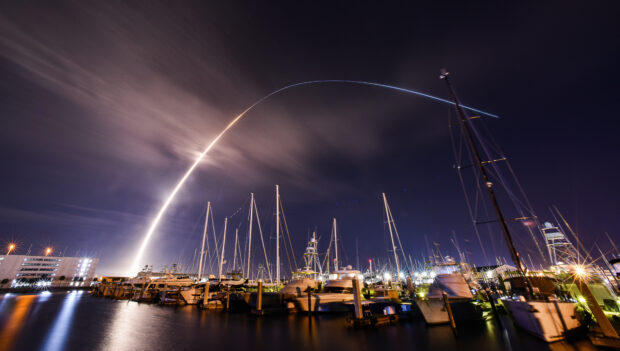Moon landing try by US firm seems doomed after ‘critical’ fuel leak

CAPE CANAVERAL, Florida — The first US moon landing attempt in more than 50 years appeared to be doomed after a private company’s spacecraft developed a “critical” fuel leak just hours after Monday’s launch.
Pittsburgh-based Astrobotic Technology managed to orient its lander toward the sun so the solar panel could collect sunlight and charge its battery, as a special team assessed the status of what was termed “a failure in the propulsion system.”
It soon became apparent, however, that there was “a critical loss of fuel,” further dimming hope for what had been a planned moon landing on Feb. 23.
“We are currently assessing what alternative mission profiles may be feasible at this time,” the company said in a statement.
READ: Moon lander from US firm launches to space aboard Vulcan rocket
The problem was reported about seven hours after Monday’s predawn liftoff from Cape Canaveral Space Force Station. United Launch Alliance’s Vulcan rocket provided the lift for Astrobotic’s lander, named Peregrine, putting it on a long, roundabout path to the moon.
A propulsion system problem “threatens the ability of the spacecraft to soft land on the moon,” the company said. The lander is equipped with engines and thrusters for maneuvering, not only during the cruise to the moon but for lunar descent.
Late Monday, Astrobotic released a photo taken from a lander-mounted camera. The company said it showed a “disturbance” in a section of thermal insulation, and that aligns with what is known so far of the problem.
Astrobotic was aiming to be the first private business to successfully land on the moon, something only four countries have accomplished. A second lander from a Houston company is due to launch next month. NASA gave the two companies millions to build and fly their own lunar landers.
The space agency wants the privately owned landers to scope out the place before astronauts arrive while delivering tech and science experiments for the space agency, other countries and universities as well as odds and ends for other customers. Astrobotic’s contract with NASA for the Peregrine lander was $108 million and it has more in the pipeline.
READ: US secretive spaceplane launched on possible higher-orbit mission
Before the flight, NASA’s Joel Kearns, deputy associate administrator for exploration, noted that while using private companies to make deliveries to the moon will be cheaper and quicker than going the usual government route, there will be added risk. He stressed that the space agency was willing to accept that risk, noting Monday: “Each success and setback are opportunities to learn and grow.”
The last time the US launched a moon landing mission was in December 1972. Apollo 17’s Gene Cernan and Harrison Schmitt became the 11th and 12th men to walk on the moon, closing out an era that has remained NASA’s pinnacle.
The space agency’s new Artemis program – named after the twin sister of Apollo in Greek mythology – looks to return astronauts to the moon’s surface within the next few years. First will be a lunar fly-around with four astronauts, possibly before the end of the year.
Highlighting Monday’s moonshot was the long-delayed initial test flight of the Vulcan rocket from Cape Canaveral Space Force Station. The 202-foot (61-meter) rocket is essentially an upgraded version of ULA’s hugely successful workhorse Atlas V, which is being phased out along with the company’s Delta IV. Jeff Bezos’ rocket company, Blue Origin, provided the Vulcan’s two main engines.
ULA declared success once the lander was free of the rocket’s upper stage, nearly an hour into the flight and before the spacecraft’s propulsion system malfunctioned and prevented the solar panel from properly pointing toward the sun.
READ: Explainer: Why are space agencies racing to the moon’s south pole?
Landing on the moon has long been a series of hits and misses. The Soviet Union and the US racked up a string of successful moon landings in the 1960s and 70s, before putting touchdowns on pause. China joined the elite club in 2013 and India in 2023. But last year also saw landers from Russia and a private Japanese company slam into the moon. An Israeli nonprofit crashed in 2019.
Next month, SpaceX will provide the lift for a lander from Intuitive Machines. The Nova-C lander’s more direct one-week route could see both spacecraft attempting to land within days or even hours of one another.
Besides flying experiments for NASA, Astrobotic drummed up its own freight business, packing the 6-foot-tall (1.9-meter-tall) Peregrine lander with everything from a chip of rock from Mount Everest and toy-size cars from Mexico that will catapult to the lunar surface and cruise around, to the ashes and DNA of deceased space enthusiasts, including “Star Trek” creator Gene Roddenberry and science fiction writer Arthur C. Clarke.
The Navajo Nation recently sought to have the launch delayed because of the human remains. saying it would be a “profound desecration” of a celestial body revered by Native Americans. Astrobotic chief executive John Thornton said the December objections came too late but promised to try to find “a good path forward” with the Navajo for future missions.
One of the spaceflight memorial companies that bought room on the lander, Celestis, said in a statement that no single culture or religion owns the moon and should not be able to veto a mission. More remains are on the rocket’s upper stage, which was boosted into a perpetual orbit around the sun reaching as far out as Mars.
Cargo fares for Peregrine ranged from a few hundred dollars to $1.2 million per kilogram (2.2 pounds), not nearly enough for Astrobotic to break even. But for this first flight, that’s not the point, according to Thornton.
“A lot of people’s dreams and hopes are riding on this,” Thornton said days before the flight.